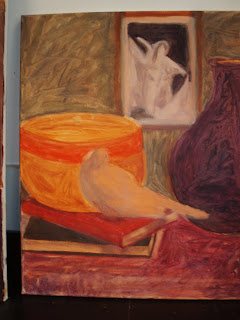
Wednesday, July 13, 2011
Thursday, January 13, 2011
Post Impressionist Style - Painting Class 2011

 Highlights and Reflections Added
Highlights and Reflections Added


Blocking in Local Color
The prupose is to get the canvas covered and to hold places for the still life objects. Objects in the still life are painted in local values using a thin transparent layer of paint. Vase and Black Book - Mix primary colors blue, rd, yellow to make black/grey.
Red Book - Mix cadmium and alizirin reds adding small amount of yellow ochre.
Bowl - Mix burnt sienna, oragne, and red.
Techniques: Drag the brush ranther than using the point to apply the paint to achieve feeling of movement in the strokes/painting. Strokes are made with the thin side of the largest possible brush. The paint is mixed on the easel to achieve the colors of objects. Allow some of the under color to show through when blocking in.

Canvas has been toned and still life objects have been abstractly drawn.

Still life arrangement that is to be painted.
Painting Steps
1) Gesso canvas.
2) Tone the canvas using mineral spirits and burnt sienna oil paint.
3) Use view finder to determine composition of painting.
4) Paint abstract forms of still life objects with burnt sienna paint onto the canvas.
5)Using burnt sienna firm up the shapes of the still life objects.
6)Using local color of objects in the still life, paint block in the still life objects onto the canvas.
Focal Point
To determine the focal point of the still life divide the canvas into thirds horizontally and vertically. Points of intersection should determine the placement of the main focal point of the painting.
Paint Brush Techniques
1)Use the largest brush possible.
2)Use the thin side of the brush to make strokes. Do not use the point of the brush.
3)Drag the brush over the canvas.
Color Mixing
Black & Greys = red, blue, yellow
Red = cadmium red and alizarin red
To dull a color use the opposite color on the color wheel.
Angles & Symmetry
Use the handle of the paint brush held to the object to determine correct angles.
Use the "dot-to-dot" method to correct symmetry of objects.
Tuesday, January 11, 2011
Thursday, December 2, 2010
Oklahoma Landscape in Fall

This was painted from a photograph of a painting provided by the instructor. The instructor painted the landscape on site at a rural setting in Oklahoma. Red sumac can be see in the background which is one of the first plants to change colors in Oklahoma each fall. Cedar trees are also common to the Oklahoma landscape and several of these can be seen in the painting. A blue sky with clouds marks the horizon and the hills are dotted with more cedar trees. In the foreground is a cuving red dirt road with a puddle of water. The composition of the painting first draws the viewer's eye to the puddle in the road in the foreground and then the road leads the viewer into the painting and to the trees, sumac, hills and sky.
Landscape Oil Painting Steps
1) Gesso canvas.
2) Tone the canvas using mineral spirits and burnt sienna oil paint.
3) Paint abstract forms of still life objects with burnt sienna paint onto the canvas.
4)Using burnt sienna firm up the shapes of the still life objects.
5)Using local color of objects in the still life,block in paint for the still life objects onto the canvas.
6.Thin tanslucent layers of paint are applied one over the other creating layers of color across the landscape.
7. Impasto painting is the next step. Paint is applied without spirits working darks and shadows into the painting first then lighter areas/colors.
Two Apples on Stripes
Monday, November 8, 2010
Subscribe to:
Comments (Atom)





